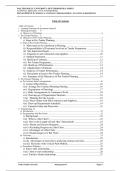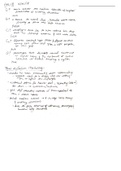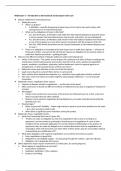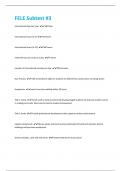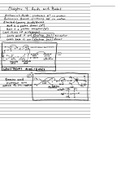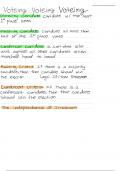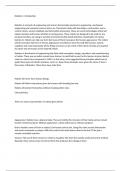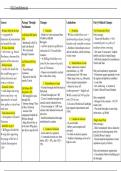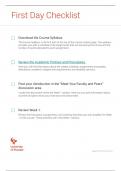WALTER SISULU UNIVERSITY: BUTTERWORTH CAMPUS
NATIONAL DIPLOMA: CIVIL ENGINEERING
MANAGEMENT II: MODULE 4: CONTRACT PROGRAMMING, PLANNING & REPORTING
Table of Contents
Table of Contents 1
1. Learning Outcomes & assessment criteria3
2. Planning principles 4
a) Objectives of Planning......................................................................................................................4
3. Pre-Tender Planning 5
b) Objectives of Pre-Tender Planning...................................................................................................5
i) Steps in Pre-Tender Planning.............................................................................5
c) Steps in Pre-Tender Planning............................................................................................................7
i) Main items to be considered at Meeting...........................................................7
ii) Responsibilities of Personnel Involved in Tender Preparation.........................7
iii) Site Inspection Report......................................................................................9
iv) Enquiries to sub-contractors and suppliers....................................................10
v) Method Statements..........................................................................................11
vi) Build up of estimate.......................................................................................12
vii) Pre-Tender Programme.................................................................................12
viii) Build up of Preliminaries.............................................................................13
ix) Adjudication of Estimate...............................................................................14
x) Analysis of Tender Performance.....................................................................14
xi) Documents to keep in Pre-Tender Planning..................................................14
xii) Summary of the Objectives of Pre-Tender Planning....................................15
8. Pre-Contract Planning 15
a) Pre-Contract Initial Arrangements..................................................................................................16
i) Contact Other Parties.......................................................................................16
xiii) Arrange Pre-Contract Planning Meeting.....................................................16
xiv) Registration of Drawings.............................................................................17
xv) Make Arrangements to Commence Work....................................................18
xvi) Drawing up of Organization Structure.........................................................18
xvii) Planning the Site Layout............................................................................18
xviii) Place Orders with Sub-Contractor and Suppliers......................................19
xix) Draw up Requirement Schedules.................................................................19
xx) Variation Order and Dayworks.....................................................................21
4. Programming 22
a) Introduction.....................................................................................................................................22
a) Programming with Bar Charts........................................................................................................23
i) Background......................................................................................................23
xxi) What is a Bar Chart?....................................................................................23
xxii) How is the Length of Each ‘Bar’ Determined?..........................................23
xxiii) Master and Section Programs....................................................................24
xxiv) Recording Progress on a Bar Chart............................................................24
xxv) Advantages of a Bar Chart..........................................................................24
xxvi) Disadvantages of a Bar Chart....................................................................24
b) Networks.........................................................................................................................................25
i) Introduction......................................................................................................25
xxvii) Advantages of networks in analysing contract activities..........................25
xxviii) Elements of the Critical Path Method......................................................25
c) Precedence Diagrams......................................................................................................................26
i) End to start relationship...................................................................................26
xxix) Start to start relationship............................................................................26
xxx) Finish to finish relationship........................................................................27
Walter Sisulu University Management II Page4.1
,WALTER SISULU UNIVERSITY: BUTTERWORTH CAMPUS
NATIONAL DIPLOMA: CIVIL ENGINEERING
MANAGEMENT II: MODULE 4: CONTRACT PROGRAMMING, PLANNING & REPORTING
xxxi) Lag finish to start.......................................................................................27
xxxii) Lag start to start........................................................................................27
xxxiii) Lead finish to finish.................................................................................27
3...........................................................................................................................27
xxxiv) Lag start to start and finish to finish........................................................27
d) Crashing a project...........................................................................................................................28
i) Background......................................................................................................28
xxxv) Steps in the Crashing Procedure...............................................................28
Resource Levelling.............................................................................................................................32
e) Measurement of Progress in terms of Time and Cost.....................................................................34
Annexures:
Annexure 4A: Contract stages during a Construction Project
Annexure 4B: Dayworks schedule
Tutorials
Walter Sisulu University Management II Page4.2
,WALTER SISULU UNIVERSITY: BUTTERWORTH CAMPUS
NATIONAL DIPLOMA: CIVIL ENGINEERING
MANAGEMENT II: MODULE 4: CONTRACT PROGRAMMING, PLANNING & REPORTING
1. Learning Outcomes & assessment criteria
Specified Learning Outcomes Assessment Criteria:
Students must be able to:
1. Demonstrate an understanding of 1. Identify and demonstrate a basic knowledge of the
principles and application of objectives of Planning.
Contract Planning, Programming & 2. Identify and demonstrate a basic knowledge of the
Reporting techniques. following Pre-tender Planning issues:
2.1. Objectives of Pre-Tender Planning
2.2. Steps in Pre-Tender Planning
2.3. Tender Site Inspections
2.4. Purpose and compilation of Method Statements
2.5. Compilation of a Pre-Tender Programme
2.6. Build-up of Preliminaries
2.7. Type and purpose of Tender Planning documents
3. Identify and demonstrate a basic knowledge of the
following Pre-Contract Planning issues:
3.1. Pre-contract initial arrangements
3.2. Handling of Drawings
3.3. Arrangements in preparation to Commence Work
3.4. Setting up a Site Organisation Structure
3.5. Planning the Site Layout (Site Establishment)
3.6. Communication with Suppliers and
Subcontractors
4. Identify and demonstrate a basic knowledge of the
purpose and method of compiling Contract Schedule
requirements including:
4.1. Labour schedules
4.2. Material schedules
4.3. Plant schedules
4.4. Equipment schedules
4.5. Subcontractors schedules
4.6. Suppliers schedules
4.7. Information schedules
5. Identify and demonstrate a basic knowledge of Bar
Charts in terms of:
5.1. Purpose and application of master and section
programmes
5.2. Method of recording Progress on a Bar Chart
5.3. Advantages & Disadvantages of a Bar Chart
6. Identify and demonstrate a basic knowledge with the
compilation and use of Networks including ability to:
6.1. Represent logical relationships
6.2. Compile precedence diagrams
6.3. Represent lag and lead time
6.4. Establishing Project Duration
6.5. Establishing the Critical Path
7. Identify and demonstrate a basic knowledge to
measure progress on a project in terms of Time and
Cost by determining the following project parameters:
7.1. Budget at Completion (BAC)
7.2. Percentage complete (PC)
7.3. Budgeted Cost for Work Scheduled (BCWS)
Walter Sisulu University Management II Page4.3
, WALTER SISULU UNIVERSITY: BUTTERWORTH CAMPUS
NATIONAL DIPLOMA: CIVIL ENGINEERING
MANAGEMENT II: MODULE 4: CONTRACT PROGRAMMING, PLANNING & REPORTING
7.4. Budgeted Cost for Work Performed (BCWP)
7.5. Actual Cost of Work Performed (ACWP)
7.6. Estimate at Completion (EAC)
7.7. Schedule Variance (SV)
7.8. Cost Variance (CV)
8. Identify and demonstrate a basic knowledge of
methods to manipulate or accelerate a programme by:
8.1. Applying a crashing procedure to a programme
8.2. Determining the revised duration after crashing a
programme
8.3. Applying Resource Levelling techniques,
through an understanding of:
8.3.1.Its meaning and uses
8.3.2.Its method of application
2. Planning principles
Planning is the investigation and forecasting of future events.
Before a construction company submits its Tender Price it must PLAN the future contract so
that the most efficient and economical use of labour and plant is considered. Any contract
which is planned efficiently at Pre-Tender stage will be priced competitively.
a) Objectives of Planning
(i) to show the quickest and cheapest method of carrying out the work consistent
with the available resources of the contractor;
(ii) to ensure by the proper phasing of operation with balanced labour gangs in all
trades continuous productive work for all the operatives employed and to
reduce unproductive time to a minimum;
(iii) to provide an assessment of the level of productivity in all trades so as to
permit the establishment of equitable bonus targets;
(iv) to determine attendance dates and periods for all sub-contractors work ;
(v) to provide information on material quantities and essential delivery dates, the
quantity and capacity of the plant required and the periods it will be on
site;
(vi) to provide, at any time during the contract, a simple and rapid method of
measuring progress, for the contractor’s information, the engineer’s
periodical certificate or the valuation of work for accounting purposes.
In any successful contract there are 3 kinds of Planning:
1. PRE-TENDER PLANNING
2. PRE-CONTRACT PLANNING
3. CONTRACT PLANNING
Walter Sisulu University Management II Page4.4
NATIONAL DIPLOMA: CIVIL ENGINEERING
MANAGEMENT II: MODULE 4: CONTRACT PROGRAMMING, PLANNING & REPORTING
Table of Contents
Table of Contents 1
1. Learning Outcomes & assessment criteria3
2. Planning principles 4
a) Objectives of Planning......................................................................................................................4
3. Pre-Tender Planning 5
b) Objectives of Pre-Tender Planning...................................................................................................5
i) Steps in Pre-Tender Planning.............................................................................5
c) Steps in Pre-Tender Planning............................................................................................................7
i) Main items to be considered at Meeting...........................................................7
ii) Responsibilities of Personnel Involved in Tender Preparation.........................7
iii) Site Inspection Report......................................................................................9
iv) Enquiries to sub-contractors and suppliers....................................................10
v) Method Statements..........................................................................................11
vi) Build up of estimate.......................................................................................12
vii) Pre-Tender Programme.................................................................................12
viii) Build up of Preliminaries.............................................................................13
ix) Adjudication of Estimate...............................................................................14
x) Analysis of Tender Performance.....................................................................14
xi) Documents to keep in Pre-Tender Planning..................................................14
xii) Summary of the Objectives of Pre-Tender Planning....................................15
8. Pre-Contract Planning 15
a) Pre-Contract Initial Arrangements..................................................................................................16
i) Contact Other Parties.......................................................................................16
xiii) Arrange Pre-Contract Planning Meeting.....................................................16
xiv) Registration of Drawings.............................................................................17
xv) Make Arrangements to Commence Work....................................................18
xvi) Drawing up of Organization Structure.........................................................18
xvii) Planning the Site Layout............................................................................18
xviii) Place Orders with Sub-Contractor and Suppliers......................................19
xix) Draw up Requirement Schedules.................................................................19
xx) Variation Order and Dayworks.....................................................................21
4. Programming 22
a) Introduction.....................................................................................................................................22
a) Programming with Bar Charts........................................................................................................23
i) Background......................................................................................................23
xxi) What is a Bar Chart?....................................................................................23
xxii) How is the Length of Each ‘Bar’ Determined?..........................................23
xxiii) Master and Section Programs....................................................................24
xxiv) Recording Progress on a Bar Chart............................................................24
xxv) Advantages of a Bar Chart..........................................................................24
xxvi) Disadvantages of a Bar Chart....................................................................24
b) Networks.........................................................................................................................................25
i) Introduction......................................................................................................25
xxvii) Advantages of networks in analysing contract activities..........................25
xxviii) Elements of the Critical Path Method......................................................25
c) Precedence Diagrams......................................................................................................................26
i) End to start relationship...................................................................................26
xxix) Start to start relationship............................................................................26
xxx) Finish to finish relationship........................................................................27
Walter Sisulu University Management II Page4.1
,WALTER SISULU UNIVERSITY: BUTTERWORTH CAMPUS
NATIONAL DIPLOMA: CIVIL ENGINEERING
MANAGEMENT II: MODULE 4: CONTRACT PROGRAMMING, PLANNING & REPORTING
xxxi) Lag finish to start.......................................................................................27
xxxii) Lag start to start........................................................................................27
xxxiii) Lead finish to finish.................................................................................27
3...........................................................................................................................27
xxxiv) Lag start to start and finish to finish........................................................27
d) Crashing a project...........................................................................................................................28
i) Background......................................................................................................28
xxxv) Steps in the Crashing Procedure...............................................................28
Resource Levelling.............................................................................................................................32
e) Measurement of Progress in terms of Time and Cost.....................................................................34
Annexures:
Annexure 4A: Contract stages during a Construction Project
Annexure 4B: Dayworks schedule
Tutorials
Walter Sisulu University Management II Page4.2
,WALTER SISULU UNIVERSITY: BUTTERWORTH CAMPUS
NATIONAL DIPLOMA: CIVIL ENGINEERING
MANAGEMENT II: MODULE 4: CONTRACT PROGRAMMING, PLANNING & REPORTING
1. Learning Outcomes & assessment criteria
Specified Learning Outcomes Assessment Criteria:
Students must be able to:
1. Demonstrate an understanding of 1. Identify and demonstrate a basic knowledge of the
principles and application of objectives of Planning.
Contract Planning, Programming & 2. Identify and demonstrate a basic knowledge of the
Reporting techniques. following Pre-tender Planning issues:
2.1. Objectives of Pre-Tender Planning
2.2. Steps in Pre-Tender Planning
2.3. Tender Site Inspections
2.4. Purpose and compilation of Method Statements
2.5. Compilation of a Pre-Tender Programme
2.6. Build-up of Preliminaries
2.7. Type and purpose of Tender Planning documents
3. Identify and demonstrate a basic knowledge of the
following Pre-Contract Planning issues:
3.1. Pre-contract initial arrangements
3.2. Handling of Drawings
3.3. Arrangements in preparation to Commence Work
3.4. Setting up a Site Organisation Structure
3.5. Planning the Site Layout (Site Establishment)
3.6. Communication with Suppliers and
Subcontractors
4. Identify and demonstrate a basic knowledge of the
purpose and method of compiling Contract Schedule
requirements including:
4.1. Labour schedules
4.2. Material schedules
4.3. Plant schedules
4.4. Equipment schedules
4.5. Subcontractors schedules
4.6. Suppliers schedules
4.7. Information schedules
5. Identify and demonstrate a basic knowledge of Bar
Charts in terms of:
5.1. Purpose and application of master and section
programmes
5.2. Method of recording Progress on a Bar Chart
5.3. Advantages & Disadvantages of a Bar Chart
6. Identify and demonstrate a basic knowledge with the
compilation and use of Networks including ability to:
6.1. Represent logical relationships
6.2. Compile precedence diagrams
6.3. Represent lag and lead time
6.4. Establishing Project Duration
6.5. Establishing the Critical Path
7. Identify and demonstrate a basic knowledge to
measure progress on a project in terms of Time and
Cost by determining the following project parameters:
7.1. Budget at Completion (BAC)
7.2. Percentage complete (PC)
7.3. Budgeted Cost for Work Scheduled (BCWS)
Walter Sisulu University Management II Page4.3
, WALTER SISULU UNIVERSITY: BUTTERWORTH CAMPUS
NATIONAL DIPLOMA: CIVIL ENGINEERING
MANAGEMENT II: MODULE 4: CONTRACT PROGRAMMING, PLANNING & REPORTING
7.4. Budgeted Cost for Work Performed (BCWP)
7.5. Actual Cost of Work Performed (ACWP)
7.6. Estimate at Completion (EAC)
7.7. Schedule Variance (SV)
7.8. Cost Variance (CV)
8. Identify and demonstrate a basic knowledge of
methods to manipulate or accelerate a programme by:
8.1. Applying a crashing procedure to a programme
8.2. Determining the revised duration after crashing a
programme
8.3. Applying Resource Levelling techniques,
through an understanding of:
8.3.1.Its meaning and uses
8.3.2.Its method of application
2. Planning principles
Planning is the investigation and forecasting of future events.
Before a construction company submits its Tender Price it must PLAN the future contract so
that the most efficient and economical use of labour and plant is considered. Any contract
which is planned efficiently at Pre-Tender stage will be priced competitively.
a) Objectives of Planning
(i) to show the quickest and cheapest method of carrying out the work consistent
with the available resources of the contractor;
(ii) to ensure by the proper phasing of operation with balanced labour gangs in all
trades continuous productive work for all the operatives employed and to
reduce unproductive time to a minimum;
(iii) to provide an assessment of the level of productivity in all trades so as to
permit the establishment of equitable bonus targets;
(iv) to determine attendance dates and periods for all sub-contractors work ;
(v) to provide information on material quantities and essential delivery dates, the
quantity and capacity of the plant required and the periods it will be on
site;
(vi) to provide, at any time during the contract, a simple and rapid method of
measuring progress, for the contractor’s information, the engineer’s
periodical certificate or the valuation of work for accounting purposes.
In any successful contract there are 3 kinds of Planning:
1. PRE-TENDER PLANNING
2. PRE-CONTRACT PLANNING
3. CONTRACT PLANNING
Walter Sisulu University Management II Page4.4

